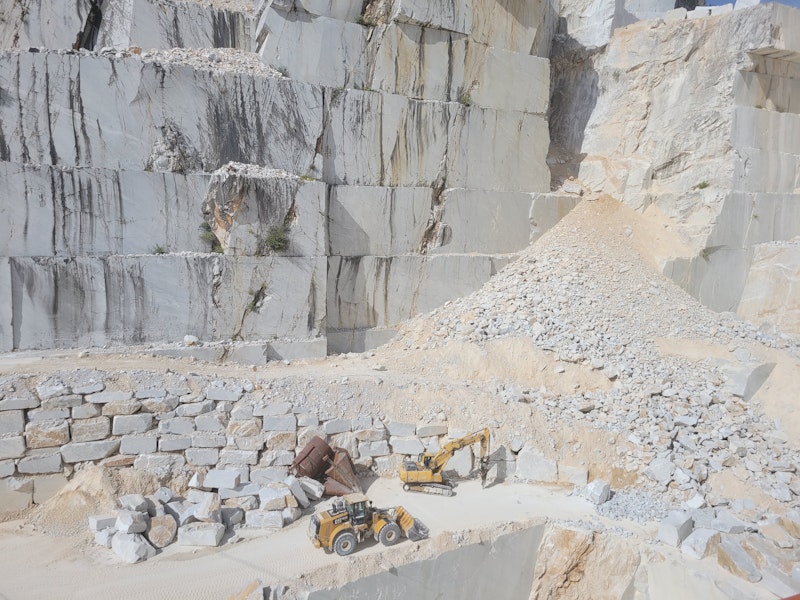A week in Tuscany, prior to moving on to Rome, enabled my wife, an architectural lighting-designer, to fulfill her longtime ambition to see the source of Carrara marble. This is the material Michelangelo used in his sculptures, excavated from quarries around the city of Carrara, in the Apuan Alps. Our house, rented with friends in the remote village of Viano, was also in these mountains, so we got to Carrara through narrow, winding roads, a morning drive of a little over an hour.
We parked on the city’s outskirts, and seven of us piled into the 4x4 driven by our guide, a friendly woman who leads groups in English, and is from Germany; I never got her name during the two-and-a-half-hour tour. The quarry, Cave di Marmo, is accessible only by off-road vehicles, and she drove up the rough mountain road with aplomb. Cave, pronounced “ca-vay,” refers to an excavated site; a natural cave in Italy is a grotta. There are some 190 quarries around Carrara. According to our guide, no one knows exactly where Michelangelo’s marbles came from. She said Michelangelo didn’t go into the quarries, contrary to reports of him visiting sites to hand-select blocks.
The mountain had been carved open, exposing vast walls of marble, bright white with streaks of gray and brown. Excavation is done by a small crew, just 11 people at this site, with vehicles equipped with three types of giant power tools—chainsaws, drills and flywheels; all are encrusted with hard industrial diamonds. A quarry boss makes day-to-day decisions as the rock emerges, seeking the most promising spots. Rainwater is collected and used for cooling during the cutting, and to remove powder. For centuries, this was a far more labor-intensive activity. Until the 1970s, excavation was done by hand, with hammers and chisels, the blocks transported on wooden sleds. The industry dates to 177 BC, beginning with settlers during the Roman Republic.
After seeing the mountain’s exterior, we were driven through a tunnel into a large space where the excavation is done from within. Digging into mountains and then down avoids chiseling off the tops of the peaks, which would run afoul of environmental rules. In recent years, a “no cav” movement has pressed to shut down the industry altogether. That’s unlikely to happen soon, given worldwide demand for the high-quality stone, and as there are vast reserves yet untapped. It’s estimated that 5.5 percent of the marble around Carrara has been retrieved over the past 2200 years.
Some five to six million tons of Carrara marble are now excavated per year. It has some 60 to 65 shades of white or gray. While the material’s well-known for its use in counters, floors, tables, and so on, particularly for high-end kitchens and bathrooms, some 2.5 million tons aren’t usable in solid form but rather converted into powder. That material doesn’t go to waste; it’s processed as calcium carbonate, useful for its delicate abrasiveness and edibility; it’s in products such as toothpaste, yogurt, cookies, calcium supplements, detergents, beauty creams, polishes and shiny papers.
The vast wealth of the Carrara quarries is concentrated in few hands. In 1751, the sovereign Duchess of Massa and Princess of Carrara, Maria Teresa Cybo-Malaspina, granted property rights to people willing to excavate the quarries; her benefit would be in charging tolls on the roads by which the marble was transported. The quarry rights have been passed down by inheritance, remaining in the hands of some 70 wealthy families, which form a lobby against taxes, and tolls are no longer charged. Carrara is one of Italy’s poorer cities, recently requiring EU support to build a road so that marble-laden trucks can circumvent the downtown area, alleviating accidents and pollution.
The day after visiting the quarry, we drove over two hours to Florence, visiting among other places the Accademia, where Michelangelo’s David is displayed. I’d never seen it in person; on my previous visit to Florence, in 1996, I only saw the replica in front of the Palazzo Vecchio, and I can’t recall if I decided that was good enough or if I didn’t even know it was a reproduction until later. The original is worth viewing at length and from a variety of angles. It came from a flawed and rejected marble block, damaged by previous sculptors who’d abandoned the project.
—Kenneth Silber is author of In DeWitt’s Footsteps: Seeing History on the Erie Canal and posts at Post.News.

